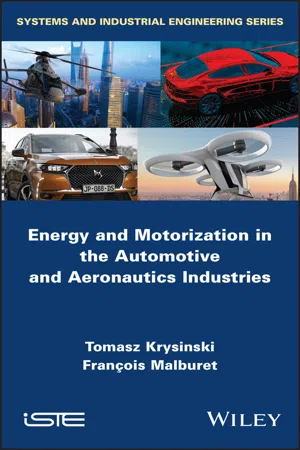
Energy and Motorization in the Automotive and Aeronautics Industries
- English
- ePUB (mobile friendly)
- Available on iOS & Android
Energy and Motorization in the Automotive and Aeronautics Industries
About This Book
The book is intended for students in engineering school or university, young engineers or newcomers in the automotive industry or aeronautics. The objective is to describe in a simple and clear way the problem of energy and motorization for the automobile, helicopters or airplanes. The front-end treatment of these industrial sectors makes it possible to analyze in an original way the similarities and differences of these different means of transport. For this, and based on current technologies and tomorrow, it specifically describes the problem of the energy requirement of cars and aircraft. The result is a search for an ideal motorization associated with the behavior of these different means of transport followed by the analysis of the performances of the various types of engines by covering gas turbines, internal combustion engines and electric motors. Transmission elements such as aerospace gearboxes or gearboxes are described as well as a chapter on energy storage means and their performance including batteries, supercapacitors, inertial or pneumatic storage, hydrogen or fuels from fossil fuels. A final chapter shows the interest and prospects of energy hybridization and electrification for the progressive replacement of fossil fuels. Beyond the technological descriptions, the book focuses on proposing basic sizing rules in order to justify certain performances and to give the reader the means to appropriate the basic know-how of these industrial sectors.
Frequently asked questions
Information
1
Motorization and Reflection on Ideal Engines
1.1. Motorization for an aircraft
1.1.1. Helicopters
1.1.1.1. Determination of hover flight power
1.1.1.1.1. Froude’s theory

Table of contents
- Cover
- Table of Contents
- Title Page
- Copyright Page
- Foreword
- Preface
- Introduction Energy Issues Linked to Transportation Powertrains
- 1 Motorization and Reflection on Ideal Engines
- 2 Engine Technologies
- 3 Power Transmission Elements
- 4 Energy Storage
- 5 Hybridization
- References
- Index
- Other titles from ISTE in Systems and Industrial Engineering – Robotics
- End User License Agreement